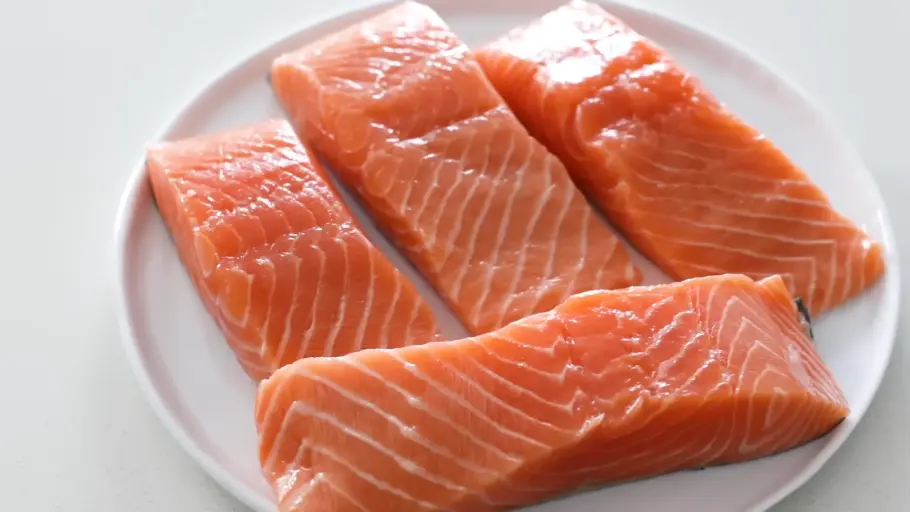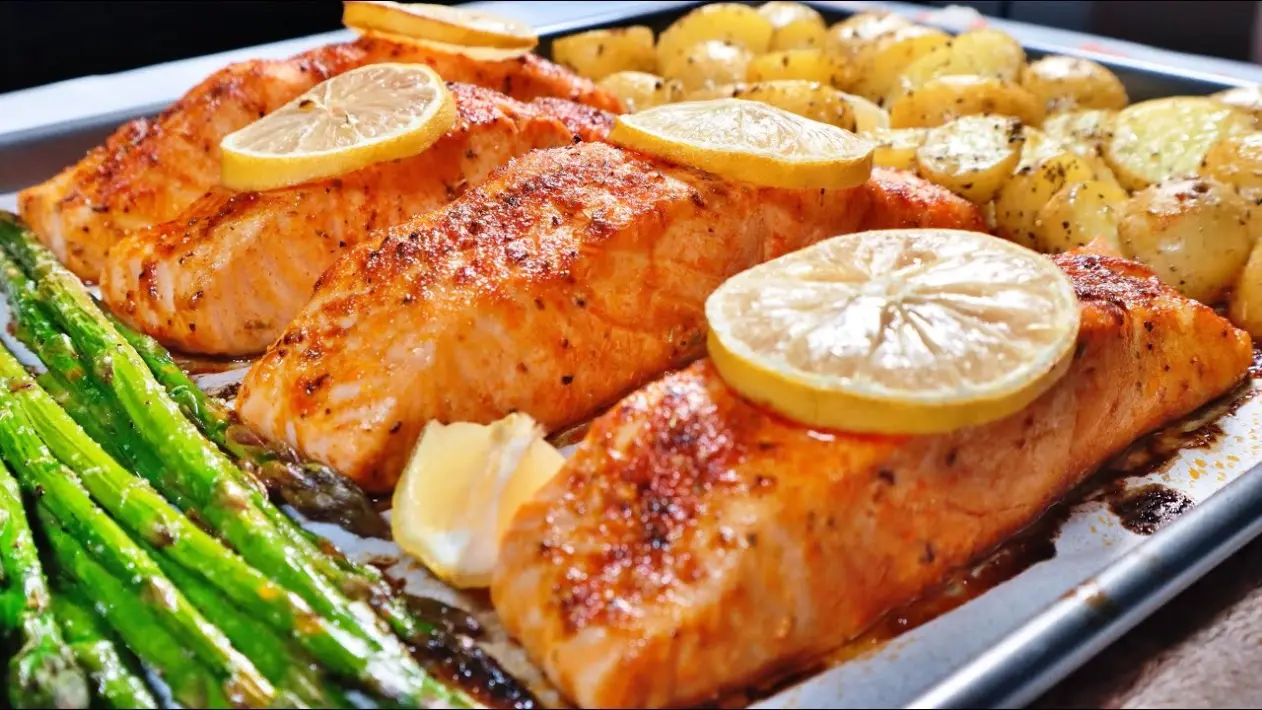Introduction
Baked Salmon Recipes, known for its vibrant color and rich flavor, stands as a favorite in the realm of healthy, delicious meals. Baked salmon offers a perfect blend of simplicity and taste, making it a popular choice for both weeknight dinners and special occasions. This recipe will guide you through the process of preparing a succulent, moist, and flavorful baked salmon that is sure to impress.
Try this How Long to Bake Salmon at 400, Salmon Poke Bowl Recipes and Easy Salmon Loaf Recipe
What is baked salmon Recipes
baked salmon Recipes is a culinary dish where salmon fillets are cooked in an oven. This method of cooking is popular for its simplicity, health benefits, and the delicious result it produces. The process typically involves seasoning the salmon with various ingredients such as herbs, spices, and citrus, and then baking it at a set temperature until the fish is tender and flaky.
Salmon is a highly nutritious fish rich in omega-3 fatty acids, proteins, and essential vitamins, making it a favored choice for those seeking a healthy diet. Baking is a preferred cooking method as it preserves the moisture and tenderness of the fish without requiring much added fat, resulting in a dish that is both flavorful and good for well-being. This dish can be served with a variety of sides, from vegetables to grains, making it versatile and suitable for many dietary preferences.
What Are the Five Types of Salmon?
Five primary types of salmon thrive in North American waters, each boasting unique characteristics and habitats. Here’s a quick look at each type:
Chinook (King) Salmon – As the largest and most prized species, anglers highly seek Chinook salmon for their substantial size and high fat content, which imparts a rich, buttery flavor. You can find them mainly in the Pacific Northwest and Alaska.
Coho (Silver) Salmon – With their bright silver skin and slightly milder taste than Chinook, Coho salmon are a favorite among sport fishers. They are smaller than Chinook but prized for their firm texture, making them ideal for grilling.
Sockeye (Red) Salmon – Featuring deep red flesh and a bold, rich flavor, Sockeye rank as the third most abundant salmon species. Their popularity spans both fresh and canned markets, and many consider them the best type of salmon for smoking.
Pink (Humpback) Salmon – As the smallest and most abundant species, Pink salmon offer a light flavor and are commonly processed into canned salmon. Their pale pink flesh is a familiar sight in rivers and streams from Washington state to Alaska.
Chum (Dog) Salmon – Known for their lower fat content, people often choose Chum salmon for dried or smoked preparations.
They have a milder flavor and firmer texture than other salmon types and are also popular for canning and salmon roe production.
Is Salmon Healthy?
Yes, salmon is considered highly healthy and is a widely recommended part of a nutritious diet. Here are several reasons why salmon is good for you:
- Rich in Omega-3 Fatty Acids: Salmon is one of the best sources of omega-3 fatty acids, which are essential fats that the body cannot produce on its own. Omega-3s are crucial for brain function, heart health, and reducing inflammation.
- High-Quality Protein: Salmon provides high-quality protein, which is vital for muscle maintenance, healing, and overall health.
- Good Source of Vitamins and Minerals: Salmon is rich in several vitamins and minerals, including B vitamins, potassium, and selenium.
- B vitamins help produce energy and maintain brain and nervous system health, while selenium supports thyroid and immune function
- May Benefit Weight Management: The combination of omega-3 fatty acids and protein can help regulate hormones that control appetite and make you feel full longer, which can help with weight control.
- Can Reduce the Risk of Heart Disease: The omega-3 fatty acids in salmon help reduce blood pressure, lower triglycerides, and can significantly decrease the risk of heart disease.
- Supports Brain Health: Eating salmon regularly can reduce the risks of dementia and depression due to its omega-3 content and other essential nutrients for brain function.

The Best Temperature for baked salmon Recipes
The best temperature for baked salmon Recipes in an oven is typically between 375°F to 400°F (190°C to 204°C). This range ensures that the salmon cooks thoroughly without drying out, allowing it to retain its moisture and tender texture.
- 375°F (190°C): Cooking at this lower end of the temperature spectrum is ideal for thicker cuts of salmon or when you prefer a slower roast to allow the flavors to meld. It results in a moist, flaky texture and is excellent for recipes that include additional sauces or toppings that might burn at higher temperatures.
- 400°F (204°C): This slightly higher temperature is effective for achieving a slightly crisper exterior while still keeping the inside moist. It is particularly suitable for fillets with skin on, as it helps crisp the skin nicely.
Cooking times will vary depending on the thickness of the salmon fillets, but a general rule is to bake for about 12 to 15 minutes at these temperatures. Always ensure that the salmon reaches an internal temperature of 145°F (63°C) when checked with a food thermometer, indicating it is cooked through and safe to eat. This method preserves the natural flavors and nutrition of the salmon, making it a simple yet delicious meal option.
How to Make baked salmon Recipes
Baked salmon is a straightforward and elegant dish that can be prepared quickly, making it perfect for both busy weeknights and special occasions. Here’s a simple recipe to make delicious baked salmon:

Ingredients
- 4 salmon fillets (about 6 ounces each)
- 2 tablespoons olive oil
- 1 tablespoon lemon juice
- Salt and freshly ground black pepper, to taste
- Optional: herbs such as dill, parsley, or thyme; garlic powder; paprika
Instructions
- Preheat Oven: Begin by preheating your oven to 400°F (204°C). This temperature allows the salmon to cook quickly while remaining moist and tender.
- Prepare the Salmon: Place the salmon fillets skin-side down on a baking sheet lined with parchment paper or lightly greased foil. This prevents sticking and makes cleanup easier.
- Season the Salmon: Brush each fillet with olive oil and lemon juice. Then, season generously with salt and pepper. If you’re using additional herbs and spices, sprinkle them evenly over the fillets now.
- Bake the salmon: Put the salmon in the oven and bake it for about 12-15 minutes, or until it cooks through and easily flakes with a fork The cooking time may vary depending on the thickness of the fillets.
- check if salmon is done, insert an instant-read thermometer into the thickest part of the fillet. It is ready when the thermometer reads 145°F (63°C).
- Serve: Remove the salmon from the oven and let it rest for a couple of minutes before serving. This allows the juices to redistribute throughout the meat, making it even more succulent.
Serving Suggestions
Baked salmon pairs wonderfully with a variety of sides. You can serve it with a fresh salad, steamed vegetables, roasted asparagus, or over a bed of quinoa or rice. For a richer flavor, drizzle a simple sauce made from dill and yogurt or a squeeze of fresh lemon juice over the top of the cooked fillets.
Tips and Suggestions
1. Choose Fresh or High-Quality Frozen Salmon
- Fresh salmon should have a bright color, firm texture, and a fresh, not fishy, smell. If purchasing frozen salmon, ensure it’s well-packaged and has no ice crystals or freezer burn.
2. Bring Salmon to Room Temperature
- Take the salmon out of the refrigerator about 15-20 minutes before you plan to cook it. This step helps the salmon cook more evenly.
3. Use Parchment Paper or Foil
- Line your baking sheet with parchment paper or foil for easier cleanup. This also prevents the salmon from sticking to the pan.
4. Don’t Overcook
- Overcooking can dry out the salmon. Keep an eye on it and check for doneness towards the end of the cooking time. Salmon is done when it flakes easily with a fork and reaches an internal temperature of 145°F (63°C).
5. Season Well
- Salmon pairs well with a variety of seasonings. Classic options include lemon, dill, garlic, and butter. For a different flavor profile, try incorporating soy sauce, ginger, and honey for an Asian twist.
6. Add a Glaze or Marinade
- To add more flavor, consider marinating your salmon for up to an hour before cooking or applying a glaze before baking. Simple glazes can be made from honey, mustard, or maple syrup mixed with spices.
7. Broil for a Crisp Finish
- If you enjoy a crispy top on your salmon, switch the oven to broil for the last 2-3 minutes of cooking. Keep a close watch to ensure it doesn’t burn.
8. Let It Rest
- Allow the salmon to rest for a few minutes after removing it from the oven. This rest period lets the juices redistribute, enhancing the moistness of the fish.
9. Experiment with Herbs and Spices
- Fresh herbs like parsley, cilantro, or basil can add a fresh, vibrant flavor to your dish. Spices like paprika or cayenne can add a little heat and color.
10. Serve Immediately
- Salmon tastes best when served fresh out of the oven. If you need to keep it warm for a short period, cover it loosely with foil.

